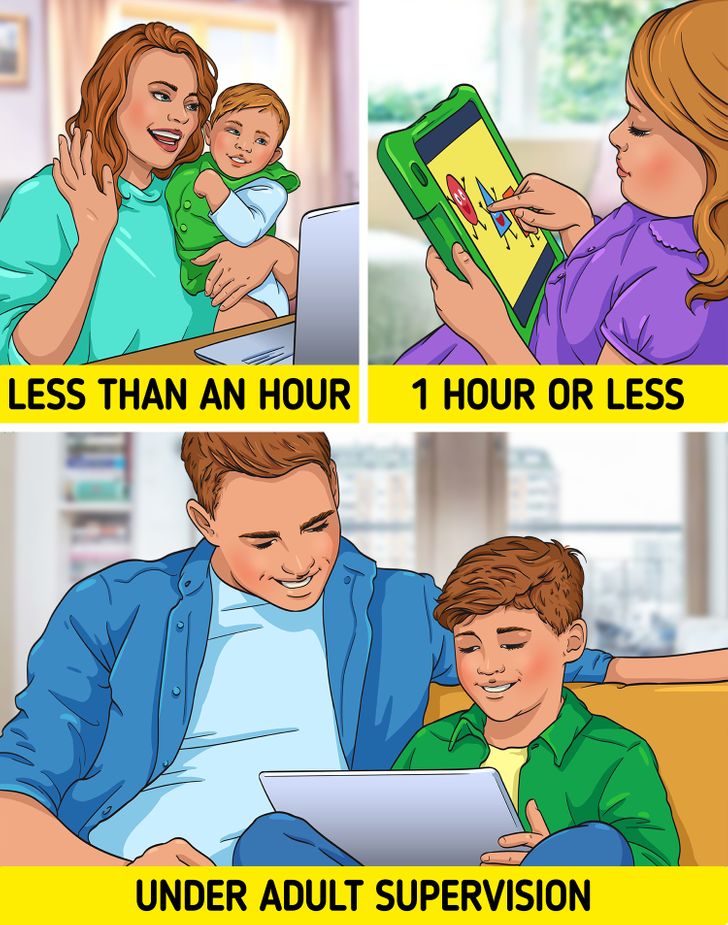How Much Screen Time Is Okay
There is no doubt electronic devices are here to stay, and many people tend to spend long hours scrolling through social media or streaming content. However, it’s essential to limit this time to avoid a number of negative consequences related to looking at a screen for too long.
5-Minute Crafts will tell you the advised screen time for adults, kids, and teenagers and will share some tips that can be useful for you and your children’s well-being.
Adults:
Advised screen time

Too much screen time in adults can lead to a wide range of adverse effects, such as insomnia, eye strain, headaches, addictive behaviors, and a reduction in physical activity levels, among other things. Additionally, research shows that adults who spend 6 hours or more in front of a screen can have a greater risk of depression.
Even though being in front of a monitor can be unavoidable if you work on a computer, health experts still recommend limiting screen time at home to 2 hours or less per day and using our spare time to engage in physical activities instead. Along those lines, there’s evidence that reducing social media use to 30 minutes a day can make a difference by improving a person’s well-being.
How to reduce and manage screen time

Although electronic devices may be an important part of your daily life, there are specific measures you can consider to decrease or manage the amount of time you spend in front of them. What’s more, these tactics may be helpful to prevent some of the negative effects.
- Don’t eat in front of a screen.
- Take note of how long you interact with your phone, TV, or tablet and redirect some of that time to physical activity or connect with other people.
- If you’re working on a computer, try to look away and focus your eyes on a distant object for 20 seconds every 20 minutes. Doing so will help you reduce eye strain.
- Use an alarm clock to wake up instead of relying on your phone. Keep it out of your bedroom.
- Turn off alerts and notifications to avoid spending extra time on your phone.
- Set a timer when you’re in front of a screen and stop using the digital device when the time is up. You can go for a walk, do some household chores, or try working out afterward.
Children and teenagers:
Advised screen time

Nowadays, digital devices are found almost everywhere, making it very difficult for parents to control the time their children spend on them. Even though some screen time can play a role in educational activities or social development, it’s essential to keep in mind the problems that overusing these devices can bring, such as impaired sleep, difficulties in learning skills, obesity, and behavioral issues.
Therefore, experts recommend the following guidelines regarding the amount of screen time children and teenagers can have per day.
- Children under 2 years old: less than an hour in the presence of an adult. For example, they may want to video-chat with family members.
- Children from 2 to 5 years old: an hour or less. For example, they may use interactive and educational media with no violence.
- Children from 5 to 18 years old: screen time can be adapted to each child or teenager, but it should be filtered by parental control systems or supervised. However, when setting your house rules regarding screen time, consider that 5-year-old children need up to 13 hours of sleep, while 18-year-old teens may need up to 10 hours, which can allow for only a few hours of recreational screen time.
Screen time tips for parents

Limit your child’s screen time by considering these tactics:
- Set device-free times and zones, such as no screens during meals or in the bedroom.
- Prioritize unplugged playtime, and encourage physical activity and social interaction.
- Turn off all screens before going to bed and require your child to keep devices out of the bedroom.
- Be a good example to your child by turning off screens when they’re not in use and limiting your screen time.
- Encourage your children to take active breaks every 30 minutes while using a screen device.

Ensure high-quality screen time by taking up the following measures:
- Preview digital media, such as apps, programs, and games, before letting your child interact or play with it.
- Keep your children close to you during screen time to supervise what they’re doing.
- Look for interactive options that make your child engage with them rather than media that only involves staring at the screen.
- Motivate your child to tell you about the media they have played with or seen during the day.
- Filter or block inappropriate content, such as violent media and ads.
- Teach your child about online safety and privacy.